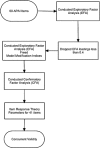Developing an African youth psychosocial assessment: an application of item response theory
- PMID: 24478113
- PMCID: PMC4098666
- DOI: 10.1002/mpr.1420
Developing an African youth psychosocial assessment: an application of item response theory
Abstract
This study aimed to refine a dimensional scale for measuring psychosocial adjustment in African youth using item response theory (IRT). A 60-item scale derived from qualitative data was administered to 667 war-affected adolescents (55% female). Exploratory factor analysis (EFA) determined the dimensionality of items based on goodness-of-fit indices. Items with loadings less than 0.4 were dropped. Confirmatory factor analysis (CFA) was used to confirm the scale's dimensionality found under the EFA. Item discrimination and difficulty were estimated using a graded response model for each subscale using weighted least squares means and variances. Predictive validity was examined through correlations between IRT scores (θ) for each subscale and ratings of functional impairment. All models were assessed using goodness-of-fit and comparative fit indices. Fisher's Information curves examined item precision at different underlying ranges of each trait. Original scale items were optimized and reconfigured into an empirically-robust 41-item scale, the African Youth Psychosocial Assessment (AYPA). Refined subscales assess internalizing and externalizing problems, prosocial attitudes/behaviors and somatic complaints without medical cause. The AYPA is a refined dimensional assessment of emotional and behavioral problems in African youth with good psychometric properties. Validation studies in other cultures are recommended.
Keywords: Africa; Uganda; children and adolescents; item response theory (IRT); mental health assessment; psychometric measurement.
Copyright © 2014 John Wiley & Sons, Ltd.
Figures
References
-
- Achenbach T.M. (1991a) Manual for the Child Behavior Checklist/4‐18 and 1991 Profile, Burlington, VT, University of Vermont, Department of Psychiatry.
-
- Achenbach T.M. (1991b) Manual for the Youth Self‐Report and 1991 profile, Burlington, VT, University of Vermont, Department of Psychiatry.
-
- Achenbach T.M. (1992) Taxonomy of internalizing disorders of childhood and adolescence In Reynolds W.M. (ed.) Internalizing Disorders in Children and Adolescents, pp. 19–60, New York, Wiley.
-
- Achenbach T.M., Rescorla L.A. (2001) Manual for the ASEBA School‐age Forms & Profiles, Burlington, VT, University of Vermont, Research Center for Children, Youth, & Families.
-
- Achenbach T.M., Becker A., Dopfner M., Heiervang E., Roessner V., Steinhausen H.C., Rothenberger A. (2008) Multicultural assessment of child and adolescent psychopathology with ASEBA and SDQ instruments: research findings, applications, and future directions. Journal of Child Psychology and Psychiatry, 49(3), 251–275, DOI: JCPP1867 [pii] 10.1111/j.1469-7610.2007.01867.x [doi] - DOI - PubMed
Publication types
MeSH terms
Grants and funding
LinkOut - more resources
Full Text Sources
Other Literature Sources
Medical




